
Dimdima
Online Children's Magazine from India

Dimdima
Online Children's Magazine from India
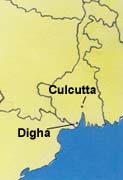
From Orissa, the land of temples, our journey takes us to West Bengal, the land of sages and poets.
The coastal strip beyond Orissa along the district of Midnapur is called the Kanthi coast. Midnapur is West Bengal's second-largest district. It is best known for its high quality mats, made from Hogla grass. The district is so fertile that paddy, bananas, mangoes, jack fruits and coconuts grow in abundance here.
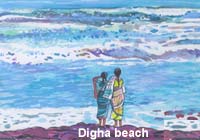 The most popular seaside resort on the Kanthi coast is Digha. Its 8-km long beach, flanked by sand dunes on one side, is one of the finest in the country. The English knew the place as 'Beercool' and Warren Hastings, the first governor-general of Bengal, described it as the 'Brighton of the East'.
The most popular seaside resort on the Kanthi coast is Digha. Its 8-km long beach, flanked by sand dunes on one side, is one of the finest in the country. The English knew the place as 'Beercool' and Warren Hastings, the first governor-general of Bengal, described it as the 'Brighton of the East'.
The calm shallow waters at Digha stretch for about a kilometre and a half into the sea. At low tide it is possible to drive down the beach without the tyres getting stuck in the sand. So firm is the sand that a light aircraft can land on it with ease.
At the end of the Kanthi coast, the river Ganga known as the Hooghly here, empties into the sea. Ships have navigated this broad, deep river from time immemorial.
Tamralipti, the present Tamluk located slightly upstream, was an important port that rose to prominence in the 6th or 5th century B.C. Emperor Asoka is said to have travelled to Tamralipti to see off the ship carrying a branch of the Bo tree under which Buddha had got enlightenment, to Sri Lanka.
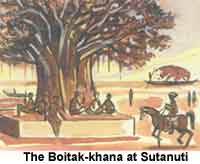 Sutanuti was a deserted village on the banks of the Hooghly.
Sutanuti was a deserted village on the banks of the Hooghly.
As the silting of the Hooghly made it difficult for large ships to sail up the river, traders set up a market at Sutanuti. They sat in the shade of a huge peepul tree, which came to be known as the 'Boitak-khana' or the sitting place and smoked hookahs as they conducted their business. One Sunday in August 1690, Job Charnock, an agent of the East India Company visited the place. Legend has it that he was so fascinated by the Boitak-khana that he chose it as the site for a warehouse for the Company. (The legendary tree was cut down in 1820 by Warren Hastings.)
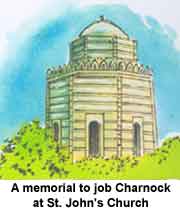 Charnock became the first governor 0f Calcutta and lived there with his Indian wife whom he had rescued from committing sati at her husband's funeral pyre. Charnock died in Calcutta. His grave can be seen in St. John's Church.
Charnock became the first governor 0f Calcutta and lived there with his Indian wife whom he had rescued from committing sati at her husband's funeral pyre. Charnock died in Calcutta. His grave can be seen in St. John's Church.
A mispronunciation of the name Kalikata, by the British is said to have given rise to the name Calcutta. Many Bengalis believe that the city got its name because of the kal kat, the Bengali word for lime kilns, that existed in plenty there.
Of the 11 major ports in the country, Calcutta is the only riverine port. It is situated about 232km away from the sea. The port faces severe navigational problems and has to be constantly dredged. Ships have to be piloted across the river. There is fluctuation in the water's depth everyday and so the river has to be surveyed and charted continuously. The port at Haldia, downstream of Calcutta was commissioned in 1977 on account of the navigational problems faced at Calcutta. The Haldia port has one of the largest lock entrances in the world.
Until 1943, Calcutta was connected with Haora (Howrah), West Bengal's smallest district by the Haora bridge, a floating bridge. Heavy traffic congestion led to the replacement of the bridge by the 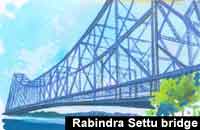 Rabindra Settu bridge, the largest cantilever bridge in the country. It is 457m long, has 8 lanes of traffic and 2 footpaths and is one of the busiest bridges in the world.
Rabindra Settu bridge, the largest cantilever bridge in the country. It is 457m long, has 8 lanes of traffic and 2 footpaths and is one of the busiest bridges in the world.
The Botanical Gardens at Shibpur in 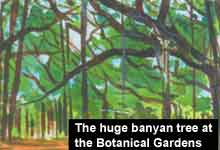 Haora was established in 1786. The garden is famous for its huge banyan tree which is 24.4m high and has a circumference of over 366m. Despite fungus having destroyed the main trunk, the tree with over a thousand roots remains healthy and continues to sprout more roots.
Haora was established in 1786. The garden is famous for its huge banyan tree which is 24.4m high and has a circumference of over 366m. Despite fungus having destroyed the main trunk, the tree with over a thousand roots remains healthy and continues to sprout more roots.
There are over 12,000 exotic plants here. They include giant water-lilies of the Amazon, nutmeg trees from Moluccas and oil palms from West Africa like the 24m high Carypha elata, which blooms just once in 40 years, giving out only one flower.
The Central National Herbarium in the garden has over 2.5million dried plants, and a valuable collection of books, journals and manuscripts on botany, forestry, agriculture, entomology and geology.
The international headquarters of the Ramakrishna Mission is located at Belur, north of Haora. It was founded in 1899 by Swami Vivekananda, who was the disciple of Ramakrishna Paramahamsa, the great saint who lived in the 19th century and preached the unity of all religions.
The Belur Math has a temple that symbolises this belief. Its architectural features are a combination 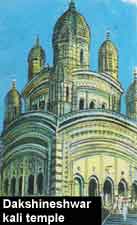 of a Hindu temple, a church and a mosque.
of a Hindu temple, a church and a mosque.
Just across the river Hooghly is the imposing Dakshineshwar Kali temple. It was while serving as a priest in this temple that Ramakrishna is said to have attained the spiritual vision of the unity of all religions. The temple was built in 1847.
South of Dakshineshwar is Kumartuli, the potters' corner. The Kumars or potters here make some of the best clay idols for Durga Puja. Most of the statues of the goddess are life-size and painted with brilliant colours. They are not baked as they are immersed in the holy river on the final day of the festival.
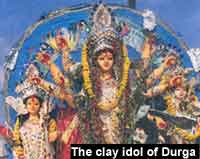 The Durga Puja is celebrated at Navratri or Dussehra around September/ October. According to legend, Durga (Parvati), the beloved daughter of Himalaya, the Lord of the mountains fell in love with Siva. Her mother, Mena, was unhappy with her choice as she felt that a life with Siva would be full of hardships. But no matter how hard her parents tried to dissuade her from marrying Siva, she was adamant and spent her days doing penance to please Siva.
The Durga Puja is celebrated at Navratri or Dussehra around September/ October. According to legend, Durga (Parvati), the beloved daughter of Himalaya, the Lord of the mountains fell in love with Siva. Her mother, Mena, was unhappy with her choice as she felt that a life with Siva would be full of hardships. But no matter how hard her parents tried to dissuade her from marrying Siva, she was adamant and spent her days doing penance to please Siva.
Touched by her devotion, Siva married her and took her home to Kailas.
The parents who were unhappy at being distanced from their daughter looked forward to the few days when she visited them every year. Many Bengalis believe that Durga Puja is a festival that celebrates this visit of the goddess to her maternal home.
Last updated on :5/28/2021
Dimdima is the Sanskrit word for ‘drumbeat’. In olden days, victory in battle was heralded by the beat of drums or any important news to be conveyed to the people used to be accompanied with drumbeats.
Bharatiya Vidya Bhavan
K. M Munshi Marg,
Chowpatty, Mumbai - 400 007
email : editor@dimdima.com
Bharatiya Vidya Bhavan
505, Sane Guruji Marg,
Tardeo, Mumbai - 400 034
email : promo@dimdima.com
Dimdima.com, the Children's Website of Bharatiya Vidya Bhavan launched in 2000 and came out with a Printed version of Dimdima Magazine in 2004. At present the Printed Version have more than 35,000 subscribers from India and Abroad.